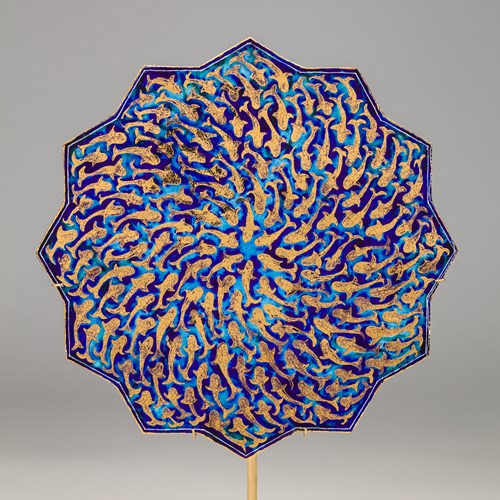Marketplace
Bidri Pandan
Bidri ware originates from the city of Bidar, in the state of Karnataka. Objects such as huqqa bases, ewers, spittoons and pandan were made from bidri from at least the beginning of the 17th century.1 The desired form is cast in an alloy of copper, tin, and principally zinc, using the cire perdue or lost wax method.2 As zinc is soft, detailed patterns can be engraved onto the surface of the object with relative ease. Inlay of silver or brass is applied to the engraved areas, in the form of sheet metal or wire. Following this, the surface of the vessel is blackened with the application of a mud paste to provide greater contrast with the inlay. After washing off the paste, the piece is oiled.3
This box was designed to hold pan, a mixture made from chopped betel nuts, spices, slaked lime, and sometimes tobacco, wrapped in a betel leaf. As this pandan only has one compartment, it can be surmised that it was used for holding the pre-wrapped quid, rather than the individual components.
Floral motifs appear in much of the decorative arts of the Deccan during the Mughal period, emerging under the influence of Persian painting and European botanical studies.4 This pandan is richly decorated with clusters of tehnishan-work (flush inlay) flowers and leaves, with interweaving stems of tarkashi (wire inlay). It was less common to have both brass and silver inlay applied to one object, making the decorative scheme of this box rather unusual.5 Eight heart-shaped silver petals surround each brass centre, forming daisy-like flowers. The ledge running below the domed lid is decorated with an alternating brass and silver teardrops, and the band below that alternating palmettes. Similar designs can be seen in Owen Jones’ The Grammar of Ornament, copied from bidri huqqas at the Great Exhibition of 1851 in London.6
An octagonal bidri pandan in the Metropolitan Museum of Art, New York, also attributed to the Deccan, has a similar decorative scheme (accession no. 1996.3a,b). A rounded pandan in the collection of the Ashmolean Museum in Oxford (accession no. EA1993.392) has similar clusters of three daisies but does not share the swirling tarkashi stems. Bearing a similar pattern, but in the more common monochrome bidri, a round pandan is found in the collection of the Louvre, Paris (accession no. MAO 2254 b).
n.b. accession nos are clickable links
1 Stronge, Susan. Bidri Ware: Inlaid Metalwork from India. London: Victoria & Albert Museum, 1985. P. 9.
2 Mittal, Jagdish. Bidri Ware and Damascene Work in Jagdish & Kamla Mittal Museum of Indian Art. Hyderabad: JKMMIA, 2011. P. 15.
3 Stronge, Susan. Op.cit. p. 11.
4 Robert, ‘A Decorative Motif in Mughal Art’, in Pratapaditya Pal (ed.) Aspects of Indian Art: Papers Presented in a Symposium at the Los Angeles County Museum of Art, October 1970.
5 Stronge, Susan. Op. cit. p. 9.
6 Jones, Owen. The Grammar of Ornament. London: 1856. pl. XLIX.
This box was designed to hold pan, a mixture made from chopped betel nuts, spices, slaked lime, and sometimes tobacco, wrapped in a betel leaf. As this pandan only has one compartment, it can be surmised that it was used for holding the pre-wrapped quid, rather than the individual components.
Floral motifs appear in much of the decorative arts of the Deccan during the Mughal period, emerging under the influence of Persian painting and European botanical studies.4 This pandan is richly decorated with clusters of tehnishan-work (flush inlay) flowers and leaves, with interweaving stems of tarkashi (wire inlay). It was less common to have both brass and silver inlay applied to one object, making the decorative scheme of this box rather unusual.5 Eight heart-shaped silver petals surround each brass centre, forming daisy-like flowers. The ledge running below the domed lid is decorated with an alternating brass and silver teardrops, and the band below that alternating palmettes. Similar designs can be seen in Owen Jones’ The Grammar of Ornament, copied from bidri huqqas at the Great Exhibition of 1851 in London.6
An octagonal bidri pandan in the Metropolitan Museum of Art, New York, also attributed to the Deccan, has a similar decorative scheme (accession no. 1996.3a,b). A rounded pandan in the collection of the Ashmolean Museum in Oxford (accession no. EA1993.392) has similar clusters of three daisies but does not share the swirling tarkashi stems. Bearing a similar pattern, but in the more common monochrome bidri, a round pandan is found in the collection of the Louvre, Paris (accession no. MAO 2254 b).
n.b. accession nos are clickable links
1 Stronge, Susan. Bidri Ware: Inlaid Metalwork from India. London: Victoria & Albert Museum, 1985. P. 9.
2 Mittal, Jagdish. Bidri Ware and Damascene Work in Jagdish & Kamla Mittal Museum of Indian Art. Hyderabad: JKMMIA, 2011. P. 15.
3 Stronge, Susan. Op.cit. p. 11.
4 Robert, ‘A Decorative Motif in Mughal Art’, in Pratapaditya Pal (ed.) Aspects of Indian Art: Papers Presented in a Symposium at the Los Angeles County Museum of Art, October 1970.
5 Stronge, Susan. Op. cit. p. 9.
6 Jones, Owen. The Grammar of Ornament. London: 1856. pl. XLIX.
Plus d'œuvres d'art de la Galerie









